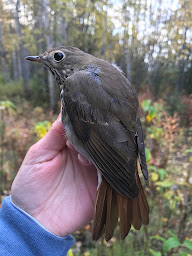It has been an eventful 2020. The global COVID-19 pandemic has changed all our lives and presented many challenges. Though we cancelled the spring banding season, the creation of rigorous health and safety protocols following guidelines of the Bird Banding Lab, North American Banding Council, other stations, and state/local guidelines allowed us to open this fall. Unfortunately it was the first year in the stations 29 year history that the station was closed to the public. We very much missed our community of volunteers and visitors who bring joy to every morning and look forward to the possibility of getting together in the future.
Okay, now the nitty-gritty! We captured over 1,600 birds from 35 different species; kingfishers and waterfowl which we are unable to band under our federal bird banding permit were released without being banded. We banded 1,425 birds of 32 different species, and twelve of 139 recaptures were returning birds. The oldest bird captured was a female American Three-toed Woodpecker who was at-least three years-old. Two returning Dark-eyed Juncos (Slate-colored) and one Yellow-rumped Warbler (Myrtle) were at least two years-old when we captured them again this year. We were excited to capture a handful of Pine Siskins, a Red-breasted Nuthatch, and two Belted Kingfishers!
We are ever thankful for our membership and generous Adopt-a-Net Sponsors who help make this work possible. Thank you so much!
Would you like to support the Creamer's Field Migration Station? Become a member at the Alaska Songbird Institute or become a 2021 Adopt-a-Net Sponsor today!!


















































